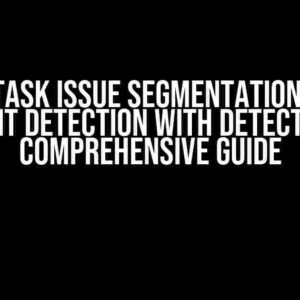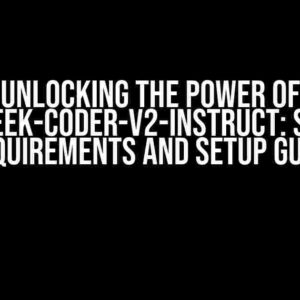Are you stuck in the Amazon SageMaker universe, trying to find your endpoint but don’t know the region? Don’t worry, my friend, you’re not alone! This comprehensive guide will take you on a journey to discover the treasure of your SageMaker endpoint, even when the region is unknown.
Why Do I Need to Find My SageMaker Endpoint?
Before we dive into the “how,” let’s talk about the “why.” Your SageMaker endpoint is a crucial part of the machine learning (ML) workflow. It’s where your trained model is deployed, and it’s responsible for handling incoming requests and sending back predictions. Without your endpoint, you can’t use your model to make predictions or integrate it with your application.
But, Why Is Finding the Endpoint So Hard?
Finding your SageMaker endpoint can be challenging, especially if you’re new to AWS or SageMaker. The main reason is that SageMakerEndpoints are region-specific, and if you don’t remember the region where you created your endpoint, it’s like searching for a needle in a haystack. Don’t worry, we’ll provide you with a step-by-step guide to find your endpoint, even when the region is unknown.
Method 1: Check Your SageMaker Console
The first place to start is your SageMaker console. This might seem obvious, but sometimes the most straightforward solutions are overlooked.
Log in to the AWS Management Consoleand navigate to the SageMaker dashboard.Click on the Regions dropdownin the top-right corner of the console.Select each regionone by one and check if your endpoint is listed under the “Endpoints” tab.
If you have a small number of regions, this method might work for you. However, if you have a large number of regions or a complex setup, this approach can become tedious.
Method 2: Use the AWS CLI
The AWS Command Line Interface (CLI) is a powerful tool that can help you find your SageMaker endpoint. You can use the AWS CLI to list all your endpoints across regions.
aws sagemaker list-endpoints --query 'Endpoints[]|[EndpointName, EndpointConfigName, ProductionVariants[]|[VariantName, DeployedImage]]' --output table --region us-west-2
This command lists all endpoints in the `us-west-2` region. To search across all regions, you can use the following script:
#!/bin/bash
for region in $(aws ec2 describe-regions --query 'Regions[].RegionName' --output text); do
echo "Checking region: $region"
aws sagemaker list-endpoints --query 'Endpoints[]|[EndpointName, EndpointConfigName, ProductionVariants[]|[VariantName, DeployedImage]]' --output table --region $region
done
This script iterates over all AWS regions and lists the endpoints in each region. You can modify the script to filter the output based on your endpoint name or other criteria.
Method 3: Use the SageMaker SDK
The SageMaker SDK provides a programmatic way to interact with the SageMaker service. You can use the SDK to list all your endpoints and filter the results based on your criteria.
import boto3
sagemaker = boto3.client('sagemaker')
regions = [region['RegionName'] for region in boto3.client('ec2').describe_regions()['Regions']]
for region in regions:
sagemaker.meta.region_name = region
response = sagemaker.list_endpoints()
for endpoint in response['Endpoints']:
print(f"Endpoint Name: {endpoint['EndpointName']}, Region: {region}")
This Python script uses the SageMaker SDK to list all endpoints across regions. You can modify the script to filter the results based on your endpoint name or other criteria.
Method 4: Check Your CloudWatch Logs
Another way to find your SageMaker endpoint is by checking your CloudWatch logs. SageMaker logs endpoint deployment and invocation events, which can help you identify the region where your endpoint is deployed.
Log in to the AWS Management Consoleand navigate to the CloudWatch dashboard.Click on the Logstab and select the log group related to your SageMaker endpoint.Filter the logsby the “Deployment” or “Invocation” event type.Check the log entryfor the region where your endpoint is deployed.
This method can be useful if you have a small number of log groups or a recent deployment. However, if you have a large number of log groups or a complex setup, this approach can be time-consuming.
Method 5: Check Your AWS CLI History
If you’ve used the AWS CLI to create or update your SageMaker endpoint, you can check your CLI history to find the region where your endpoint is deployed.
aws cloudshell history
This command lists your recent AWS CLI commands, including the region where you created or updated your endpoint.
Conclusion
Finding your SageMaker endpoint can be challenging, especially when you don’t know the region. However, by using one or more of the methods outlined in this article, you should be able to discover the treasure of your endpoint.
Remember to always keep track of your SageMaker endpoints and regions to avoid losing them in the future. You can use AWS tags or other metadata to organize and manage your endpoints more efficiently.
| Method | Description |
|---|---|
| Check SageMaker Console | Manually check each region in the SageMaker console. |
| Use AWS CLI | Use the AWS CLI to list all endpoints across regions. |
| Use SageMaker SDK | Use the SageMaker SDK to list all endpoints and filter the results. |
| Check CloudWatch Logs | Check CloudWatch logs for endpoint deployment and invocation events. |
| Check AWS CLI History | Check your AWS CLI history for recent commands. |
By following these methods, you’ll be able to find your SageMaker endpoint, even when the region is unknown. Happy treasure hunting!
Frequently Asked Question
Lost in the vast universe of AWS SageMaker? Don’t worry, we’ve got you covered!
How do I find my SageMaker endpoint if I don’t know the region?
You can find your SageMaker endpoint by logging into the AWS Management Console, navigating to the SageMaker dashboard, and clicking on the “Endpoints” tab. From there, you can search for your endpoint by name or description. If you still can’t find it, try checking the “Regions” dropdown menu to select the region where your endpoint is located.
What if I have multiple regions with similar endpoint names?
In that case, you can use the AWS CLI command `aws sagemaker list-endpoints –query ‘Endpoints[]|{EndpointName, Arn}’` to list all your endpoints across regions. This will give you the endpoint name and ARN, which includes the region. You can then use the ARN to identify the region and endpoint you’re looking for.
Can I use AWS CloudFormation to find my SageMaker endpoint?
Yes! If you created your SageMaker endpoint using AWS CloudFormation, you can find the endpoint by looking at the CloudFormation stack’s resources. You can use the AWS CLI command `aws cloudformation describe-stack-resources –stack-name
How do I find the ARN of my SageMaker endpoint if I have the name?
Easy one! You can use the AWS CLI command `aws sagemaker describe-endpoint –endpoint-name
What if I still can’t find my SageMaker endpoint?
Don’t panic! If you’ve tried all the above methods and still can’t find your endpoint, you can try reaching out to your AWS administrator or the person who created the endpoint for assistance. They may be able to help you locate the endpoint or provide more information about its creation.



